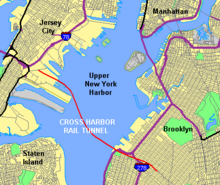Port Jersey
The area, east of the Greenville section of Jersey City was originally tidal marshes and white cedar swamps, and was first used for industrial purposes beginning in the 1800s.Anticipating the needs of the planned and existing super-panamax containerships which will call in the port upon the completion of the new Panama Canal Megalocks, NEAT was incrementally shut down and its share of the auto import/export market completely transferred to the Bayonne Auto Terminal and the Port Newark FAPS facility by 2011.The facility features 9,600 feet of track serviced by rail mounted gantry cranes that will have an annual capacity of 250,000 container lifts.The Port is primarily accessed by Exit 14A of the Newark Bay Extension of the New Jersey Turnpike, which underwent a $172 million reconstruction and expansion in 2018 to ease congestion for truckers and commuters.[27][28] The windfarm is part of a larger plan to expand the container port on the manmade peninsula to accommodate post-panamax ships.Port Jersey is the key transload terminal for solid waste from New York City barges to railcars.




Intermodal freight transportBayonneJersey CityNew JerseyPort Authority of New York and New JerseyNew York New Jersey Rail, LLCConrail Shared Assets OperationsCMA-CGMCoordinatesUSS Intrepidcontainer terminalUpper New York BayPort of New York and New JerseyHudson CountyCMA CGMpost-panamaxForeign-Trade Zone 49Hudson River Waterfront Walkwayleast ternGreenville sectionMOL BenefactorAmbrose ChannelMilitary Ocean Terminal at BayonneCape Liberty Cruise PortNew York metropolitan areaArmy Corps of EngineersGreenville YardCross-Harbor Rail TunnelBergen NeckExpressRailNational Docks SecondaryNew Jersey Route 440Bayonne BridgeStaten IslandNewark Bay ExtensionNew Jersey TurnpikeNew Jersey Route 185wind farmcontainer portGreenville Rail YardGeography of New York HarborRail freight transportation in New York City and Long IslandWind power in New JerseyThe Jersey JournalWayback MachineHowland HookPort Newark–ElizabethRed HookBrooklyn Cruise TerminalCape LibertyAtlantic CityKennedyLaGuardiaNewark LibertyStewartTeterboroGeorge Washington BridgeGoethals Bridge1928–2017 bridgeHolland TunnelLincoln TunnelOuterbridge CrossingAirTrain JFKAirTrain LaGuardiaAirTrain NewarkGateway ProjectNewark Airport StationNYNJ RailGWB Bus StationJournal Square Transportation CenterPort Authority Bus TerminalDyer AvenueHolland Tunnel RotaryGeorge Washington Bridge PlazaJFK ExpresswayLincoln Tunnel ExpresswayLincoln Tunnel HelixTrans-Manhattan Expressway178th–179th Street TunnelsBathgate Industrial ParkBattery Park City Ferry TerminalEssex County Resource Recovery FacilityNewark Legal CenterPANYNJ Police DepartmentTeleportQueens WestWorld Trade Center (2001–present)111 Eighth AvenueDowntown Manhattan HeliportHudson TerminalPort Authority Pavilion (1964–1965)West 30th Street HeliportWorld Trade Center (1973–2001)Neighborhoods in Jersey City, New JerseyBergen-LafayetteBeaconBergenBergen HillCommunipawJackson HillThe JunctionDowntownBoyle PlazaExchange PlaceHamilton ParkHarsimusLiberty HarborNewportPaulus HookVan Vorst ParkThe VillagePowerhouseGreenvilleCanal CrossingCountry VillageClaremontCurries WoodsThe HubThe HeightsCentral AvenuePalisade AvenueTransfer StationWestern SlopeJournal SquareBergen SquareFive Corners